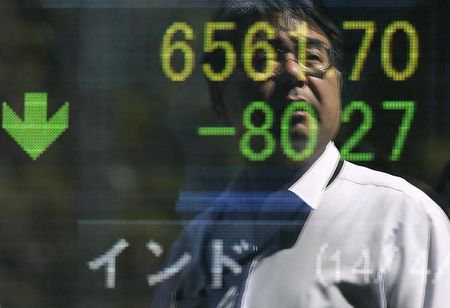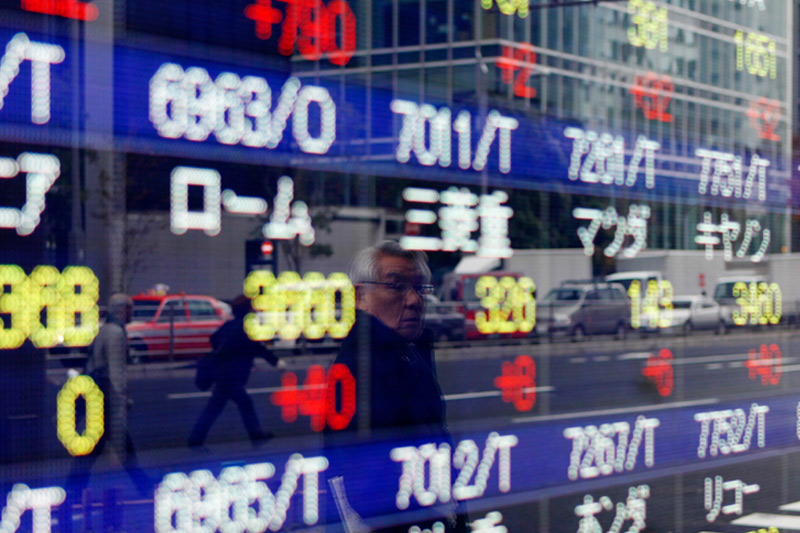By Wayne Cole
SYDNEY (Reuters) - Asian share markets were mostly in the red on Wednesday as worries about waning global growth lifted safe-haven bonds, while shoving oil prices to their lowest in more than two years.
Extending a three-month-long decline, Brent oil sank $1.18 to $90.93 a barrel while U.S. crude tumbled $1.07 to $87.78. The protracted slide should be a windfall for consumer spending power, but is also a powerful force for disinflation in much of the developed world.
That has been a boon for sovereign bonds as investors wager the outlook for slowing inflation could put off the day when U.S. interest rates might rise.
Minutes of the Federal Reserve's last policy meeting are due later in the session and markets will be acutely sensitive to how the debate between hawks and doves on the committee was playing out.
In Asia, Japan's Topix (TOPX) shed 1.1 percent while the Nikkei (N225) dropped 1.0 percent.
MSCI's broadest index of Asia-Pacific shares outside Japan (MIAPJ0000PUS) fell 1 percent, while Australia's main index (AXJO) lost 0.9 percent.
China's markets bucked the trend as they returned from a week-long break, with Shanghai (SSEC) up 0.5 percent, though Hong Kong (HSI) shed 0.7 percent.
A private survey of China's services sector showed growth eased a touch in September, but that only served to reinforce expectations of further stimulus measures by Beijing.
Stimulus is also high on the agenda in Europe after German industrial output suffered the biggest decline since the height of the financial crisis, piling pressure on the European Central Bank to be more urgent in its actions. [TOP/CEN]
The IMF on Tuesday shaved its global growth forecast to 3.3 percent for this year, from 3.4 percent, warning of weakness in the euro zone, Japan and big emerging markets such as Brazil.
"Weak numbers like the German production report fuel concern that ECB stimulus will be inadequate given the gloomier news," said Westpac analyst James Shugg.
"With the IMF waving its knife at its global growth forecasts, U.S. markets couldn't avoid the downdraft either."
The Dow (DJI) fell 1.6 percent, while the S&P 500 (SPX) lost 1.51 percent and the Nasdaq (IXIC) 1.56 percent. The pan-European FTSEurofirst 300 (FTEU3) also shed 1.5 percent.
WHAT INFLATION?
Inflation swaps for the euro zone, which essentially show what investors think inflation will average over the next five years, have been in precipitous decline, touching an historic low of 1.89 percent this week <EUIL5YF5Y=R>.
This is one of ECB President Mario Draghi's favoured measures of inflation and its decline was a major reason the central bank launched a fresh stimulus package last month.
But the downdraft in inflation expectations is hardly confined to Europe. The U.S. swaps rate has slipped to 2.62 percent <USIL5YF5Y=R>, from 2.88 percent in August, even as the run of U.S. economic data has been generally encouraging.
Likewise, longer-dated U.S. Treasury yields have fallen noticeably as investors price in low inflation for longer.
Yields on 30-year bonds (US30YT=RR) are now at their lowest since May 2013 at 3.05 percent, while their premium over two-year yields shrank to the smallest since late 2012.
Futures contracts predicting the course of the Fed funds rate <0#FF:> have rallied hard in recent days as the market pushed out the date for the first hike.
They now show less than 50 basis points of tightening for 2015 and all of it in the second half of the year.
The fall in U.S. yields initially dragged the dollar down from its recent highs, though it quickly stabilised in Asia.
The dollar index edged up to 85.860 on Wednesday, and back towards a four-year peak of 86.746 hit on Friday.
The dollar crept up to 108.40 yen <JPY=>, having been as low as 107.75 at one stage. It touched a six-year high of 110.09 just a week ago.

The euro hovered at $1.2635 <EUR=>, after its bounce petered out around $1.2683.
(Editing by Kim Coghill & Shri Navaratnam)
